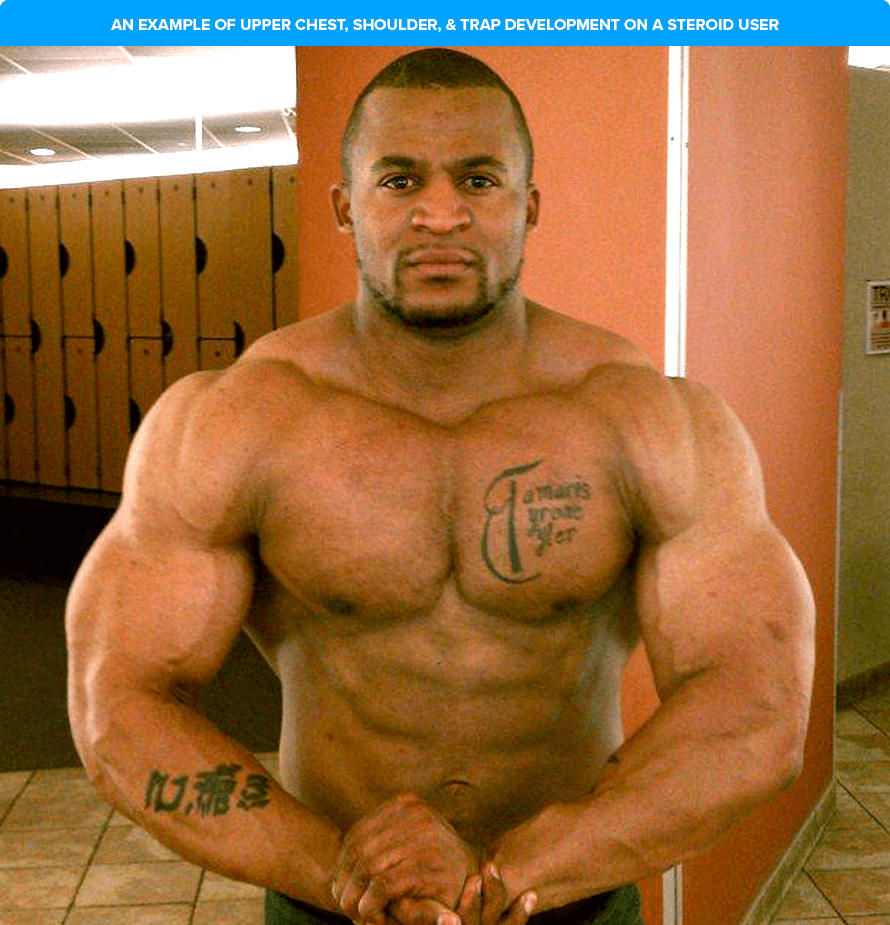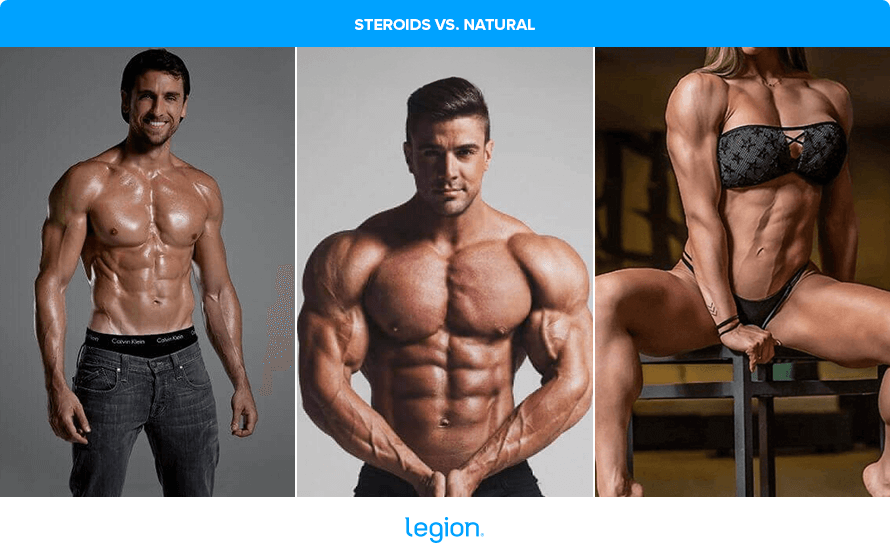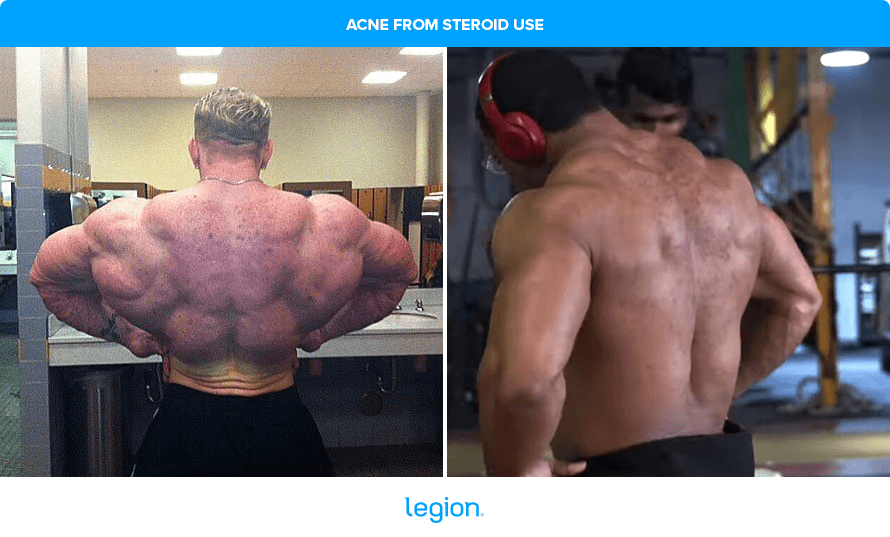8 Evidence-Based Ways to Tell If Some is “Natty” or Not
Steroid use is rampant in the fitness space.
But because of the societal stigma surrounding steroids, most “roiders” lie about their drug use.
And while this deception seems insignificant, in many cases, it’s not.
The “steroids vs natural” debate matters because many “fake” naturals use their physiques to gain followers and sell pills, powders, and PDFs.
Not only is this fundamentally dishonest, but it skews people’s expectations about what’s achievable with their own physique, which often begins a frustrating, disappointing, and dysfunctional relationship with weightlifting.
Because let’s face it: no matter your genetics or how hard you train, when it’s natural vs steroids, steroids win every time.
That’s why it’s worth knowing how to spot a fake “natty,” and why I’ve created a guide highlighting the steroids vs natural discussion.
In it, you’ll learn what natty means in the gym, 8 evidence-based ways to tell if someone is taking (or has taken steroids), and more.
- What Is “Natty” in Gym Terminology?
- Steroids vs. Natural: How to Tell If Someone Is Natty or Not
- 1. They Have a Normalized FFMI of 25 or More
- How to Tell If Someone Is Natty or Not Based on Their Normalized FFMI
- 2. They’re Very Big, Very Lean, and Very Strong
- 3. They Suddenly Got Way Stronger
- 4. They Have a Massive Upper Chest, Shoulders, and Traps
- 5. They’re “Dry” and “Full” with Amazing Muscle Separation
- 6. They Stay in Peak Shape Year Round
- 7. They Have Excellent Overall Development and Proportions
- 8. They Have Bad Acne, Fast-Growing Body Hair, and Baldness
- Why Do People Care if Someone Is Natty or Not?
- Steroids vs. Natural: FAQs
- FAQ #1: Why Do People Dislike “Fake Natties?”
- FAQ #2: What does it mean to be natty or not?
- FAQ #3:
Table of Contents
What Is “Natty” in Gym Terminology?
“Natty” is shorthand for “natural.” It refers to someone who builds their physique without using performance-enhancing drugs like anabolic androgenic steroids (or “steroids” for short).
Understanding what natty means is crucial because it forms the basis of another common talking point in the fitness space: the “natty or not” (or “steroid vs. natural”) discussion.
When people talk about whether someone is natty or not, they’re debating whether or not a person has built their physique with the help of steroids.
Steroids vs. Natural: How to Tell If Someone Is Natty or Not
Sometimes, it’s easy to tell if someone’s on steroids: if they’re an IFBB pro or look like one, for example, they’re on gear.
Other times, however, it’s less clear.
In fact, many drug users look far more “normal” than you might think, which is why you need straightforward, empirical methods of detecting steroid use.
Here are eight practical ways to assess someone’s “natty probability:”
1. They Have a Normalized FFMI of 25 or More
The fat-free mass index (FFMI) measures how much muscle you have per unit of height.
You calculate it by dividing your fat-free mass in kilograms by your height in meters squared, and you can find yours by plugging your height, weight, and body fat percentage into this calculator:
Since height and potential muscularity correlate, and organ weight is fairly consistent among people, steroid users typically have higher FFMIs than non-users.
And research confirms this. One study by McLean Hospital calculated the FFMIs of 157 male athletes (some admitted juicing, and others claimed natty status) and found that steroid users had an average FFMI of 24.8. Conversely, those claiming to be natty averaged 21.8.
No natural athlete exceeded an FFMI of 25, whereas many “enhanced” ones did, suggesting an FFMI of 25 is the natural limit for male weightlifters.
(There’s no similar research on women, but it’s fair to assume their ceiling would be significantly lower.)
One crucial caveat is that FFMI doesn’t account for differences in height, which is important because FFMI increases with height, regardless of steroid use.
The researchers were aware of this, though. After adjusting for average height, the study showed natural athletes had a normalized FFMI of 24.9 or less. At the same time, about half of the steroid users exceeded 25.
The bottom line from this study is that a normalized FFMI above 25 is proof positive for steroid use.
Naysayers will claim that old-time “natural bodybuilders” and strongmen discredit this argument since many exceeded a normalized FFMI of 25 before the advent of steroids. But there are problems with this argument.
First, there is no reliable data from the late 1800s and early 1900s about the athletes of that era. Most exaggerated their strength and size to draw crowds and sell tickets to their shows.
Additionally, testosterone was available around the time many bodybuilders crossed the 25 normalized FFMI threshold, so there’s a good chance the top athletes were taking something.
How to Tell If Someone Is Natty or Not Based on Their Normalized FFMI
Here’s what the evidence says:
- A normalized FFMI over 25 almost certainly indicates steroid use.
- Between 24 and 25 likely means steroid use.
- Between 22 and 23 for someone training for 3+ years may be natural.
- Between 21 and 22 is likely natural.
- Between 18 and 21 likely indicates someone doesn’t train, so who cares?

If you’re wondering why someone with a normalized FFMI under 25 may still be unnatural, it’s because not all steroid users have high FFMIs. Some have lower FFMIs due to factors like bad genetics, using small doses, poor training or dieting, and so forth.
So, it’s important to look at more than just the normalized FFMI to gauge if someone might be using steroids.
2. They’re Very Big, Very Lean, and Very Strong
For natural bodybuilders, achieving an impressive combination of size, leanness, and strength is a tricky balancing act. Here’s why:
- Size: To gain size, natural bodybuilders usually need to eat a lot, making it hard to stay lean.
- Leanness: To achieve a low body fat percentage, most natty bodybuilders must follow a calorie-restricted diet, which can make it difficult to gain muscle and strength.
- Strength: It’s possible to get strong without being big, but most people looking to maximize strength need a lot of muscle mass, which requires you to eat plenty of calories.
In other words, something always has to give: eating enough to gain muscle makes it hard to stay lean, and reducing calories to cut fat compromises your ability to gain muscle and strength.
That’s why when you see someone who defies these trade-offs—someone who’s very big, lean, and strong—it’s a telltale sign they’re juiced to the gills.
3. They Suddenly Got Way Stronger
You rapidly gain strength when you start lifting weights because your body is hyper-responsive to training. This is called “newbie gains.”
As you continue, though, progress slows. Initially, you might be able to add weight to the bar every week, but after several months, you might only progress every month. After five years or more of consistent training, adding weight to your bench press, squat, or deadlift each year is cause for celebration.
But steroids change the game.
For example, a study published in the New England Journal of Medicine showed that weightlifters with about a year of training experience who started taking steroids added 132 pounds to their squat and bench press in just 10 weeks.
They only took testosterone, too. If they’d combined it with other strong steroids like trenbolone and Winstrol, as many bodybuilders and powerlifters do, their results probably would have been even more extreme.
That’s why if you see an experienced weightlifter suddenly increase a major lift by 50 pounds or more in less than a year, it’s reasonable to be skeptical of their natty status.
4. They Have a Massive Upper Chest, Shoulders, and Traps
The upper chest, shoulders, and traps have a higher concentration of androgen receptors than other body parts.
Androgen receptors are particular types of proteins in cells that respond to anabolic hormones like testosterone.
Steroids supercharge these receptors, causing these muscle groups to develop faster than others.
Here’s an example of how this looks:

So, if someone looks like they’re wearing football shoulder pads beneath their skin, they’re likely taking a hefty dosage of #dedication.
5. They’re “Dry” and “Full” with Amazing Muscle Separation
When a bodybuilder looks “dry,” it means they have very low body fat and are retaining hardly any water, making their skin look thin so you can clearly see the separation between their muscles.
When they look “full,” their muscles appear large and voluminous, often because their muscle cells are saturated with glycogen and water.
It’s possible to look dry as a natural bodybuilder, but your muscles won’t look full. Or, you can look full but not dry. Steroid users, on the other hand, can enjoy the best of both worlds.
For example, here’s a shot of me (far left) at about 183 pounds and 7% body fat. Contrast it with the other fitness models, and you’ll see that when it comes to looking dry and full with clear muscle separation, there’s no comparison between steroids vs natural:

6. They Stay in Peak Shape Year Round
With proper training and dieting, natural bodybuilders can get lean and dry, but can’t maintain that look for long.
The problems are many: You can’t eat enough to feel good, your training and sleep suffer, your sex drive plummets, and you’re always tired. The human body just isn’t meant to stay that lean.
The right drugs change all of this. Suddenly, you can eat a lot while staying shredded, manage with less sleep, and still power through tough workouts.
If you have good genetics, maintaining 10% body fat for men and 20% for women year-round is possible, but it requires you to carefully watch your diet and how much you exercise. But staying lean while also enjoying significant size, energy, and conditioning is only possible with “chemical assistance.”
7. They Have Excellent Overall Development and Proportions
Most natties have one or two muscle groups that lag in size and strength.
Conversely, steroid users regularly have perfect size, symmetry, and definition in all major muscle groups.
The primary reasons for this are:
- Every cell in the body has androgen receptors, and artificially raising your androgen levels forces even stubborn muscle groups like the calves, shoulders, and arms to grow.
- Steroid users can more easily “sculpt” their bodies by neglecting their strong points (which will stay big) and hammering their weak points (which will grow rapidly).
Thus, if someone has an aesthetically perfect physique, they’re probably on the sauce.
8. They Have Bad Acne, Fast-Growing Body Hair, and Baldness
Many steroids cause physical changes typically associated with male puberty and masculinity.
Three visible changes common among steroid users are acne, thick or fast-growing facial and body hair, and hair loss or baldness.
While many bodybuilders attempt to cover up these side effects by editing photos before posting them online, having hair removed, and wearing “modest” clothing or a hat, there are plenty of candid shots online showing what these effects look like:

Why Do People Care if Someone Is Natty or Not?
People care whether someone is natty or not because it shapes how we see their physical achievements.
For example, many see being a “lifetime natty” or natural bodybuilder as a badge of honor because it means you have achieved results through diet, exercise, and dedication. In contrast, many view steroids as a shortcut.
Understanding whether someone is natural or not also helps us decide if we should trust their advice on training and diet.
Natural weightlifters typically prefer to learn from accomplished natural bodybuilders and coaches because their methods are usually more applicable and effective for those who choose not to use steroids.
In other words, knowing someone’s “natty status” helps ensure the advice you’re getting is suitable for your own natural fitness goals.
Steroids vs. Natural: FAQs
FAQ #1: Why Do People Dislike “Fake Natties?”
A “fake natty” is someone who uses steroids but claims to be natural.
The main reasons people dislike fake natties are:
- Dishonesty: The main problem with fake natties is they lie about their achievements, which is deceitful.
- Unrealistic Expectations: Fake natties set unrealistic standards for natural bodybuilders and fitness enthusiasts, which can lead people to become discouraged and frustrated when they can’t achieve similar results naturally.
- Misleading Marketing: Fake natties often use their physiques to sell products (dietary supplements, training programs, etc.), claiming anyone who follows their recommendations can achieve similar results. In other words, they trick people into buying products that don’t deliver on their promises.
FAQ #2: What does it mean to be natty or not?
When people talk about whether someone is “natty or not,” they’re discussing whether or not a person has built their physique naturally (“natty”) or with the help of steroids.
FAQ #3:
The eight most surefire ways to tell if someone is on steroids are:
- They have a normalized FFMI of 25 or more
- They’re very big, very lean, and very strong
- They suddenly got way stronger
- They have a massive upper chest, shoulders, and traps
- They’re dry and full with amazing muscle separation
- They stay in peak shape year-round
- They have excellent overall development and proportions
- They have bad acne, fast-growing body hair, and male-pattern baldness
The post 8 Evidence-Based Ways to Tell If Some is “Natty” or Not appeared first on Legion Athletics.
https://ift.tt/8vTzeDP March 29, 2024 at 06:00PM Legion Athletics
Comments
Post a Comment